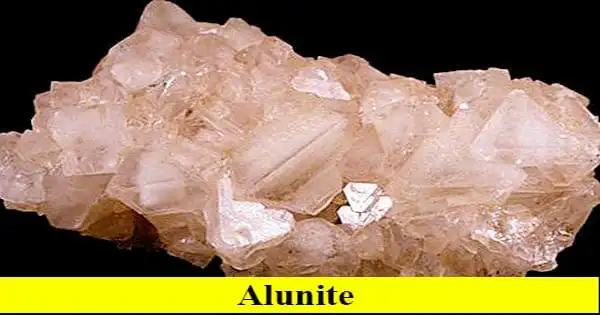Description
Alunite, commonly known as alum stone, is a mineral that contains the chemical alum, KAl(SO4)2-12H2O. Alunite has also been utilized in the recovery of potassium and aluminum.
Alunite is formed by the action of sulfuric acids on potassium-rich feldspars, a process known as “alunitization.” Sulfuric acids are commonly found in hydrothermal solutions that are rich in certain ore metals. These solutions can produce enormous masses of alunite, transforming alunite into a rock-forming material. As a result, alunite is frequently confused with huge rock-forming dolomite or limestone (calcite). Because alunite does not bubble even when powdered, an acid test should suffice for identification. Alunite may also be found in volcanic fumaroles.
The symmetry of alunite is the same as that of the other Tourmaline Group members. Alunite crystals, on the other hand, do not form prismatic crystals like the normal tourmaline material. The crystals of alunite are flatter and resemble almost cubic rhombohedrons. The “rhombohedrons” are actually two trigonal pyramids joined together.
General Information
| Category | Sulfate minerals |
| Environment | KAl3(SO4)2(OH)6 |
| Crystal system | Trigonal |
| Crystal class | Hexagonal scalenohedral (3m) |
| Synonym | Aluminilite |
Physical Properties of Alunite
| Color | White, Gray, Yellowish gray, Reddish gray, Yellowish white. |
| Cleavage | {0001} Good |
| Density | 2.59 – 2.9, Average = 2.74 |
| Fracture | Uneven |
| Hardness | 3.5-4 – Copper Penny-Fluorite |
| Luminescence | Non-fluorescent. |
| Luster | Vitreous – Pearly |
| Streak | white |
| Diaphaneity | Transparent to translucent |
History
Alunite is a mineral that was first discovered in the 15th century in the Monti della Tolfa region of northern Italy, where it was used to make alum. J.C. Delametherie coined the term aluminilite in 1707, and François Beudant coined the term alunite in 1824.
Where can you find alunite?
It is now found in the Italian town, Tolfa. It may be found in Colorado’s San Juan area, Nevada’s Goldfield, Utah’s ghost town of Alunite in Marysvale, and Arizona’s Red Mountain near Patagonia. The Arizona occurrence is located above a canyon known as Alum Gulch.

Alunite and Spiritual Healing
Alunite’s therapeutic powers are beneficial to anyone whose confidence in the divine presence has begun to wane. It especially addresses the lack of energy and drive, as well as other issues that arise as a result of this. Alunite also facilitates the process of spiritual healing by broadening your consciousness’s boundaries.
When you become more open to new and diverse experiences that may appear beyond your comprehension, you successfully push the boundaries of your mind and seek solutions.
More significantly, the energies of Alunite greatly enhance the yin-yang balance that is essential to a person’s inner equilibrium.
Why Would You Use Alunite?
If you want to use this stone for metaphysical reasons, it has the following characteristics:
- It connects with the base or root chakra, as do many red stones, helping to anchor you to the earth when needed.
- Apply to the base chakra to balance yourself if you are feeling weak and lacking in strength or stamina.
- It has a positive effect on the sacral chakra, aiding your relationships and the development of your creativity.
- Increasing your creativity allows you to put your creative talents to use in your daily life.
These stones’ properties resonate throughout the heart chakra and provide a positive vibe that will keep you emotionally balanced. Their characteristics are beneficial in balancing your masculine and female energy, which is important since imbalanced yin and yang energies can lead to sickness.
As a result, keeping them in balance is crucial in order to help you stay healthy.





